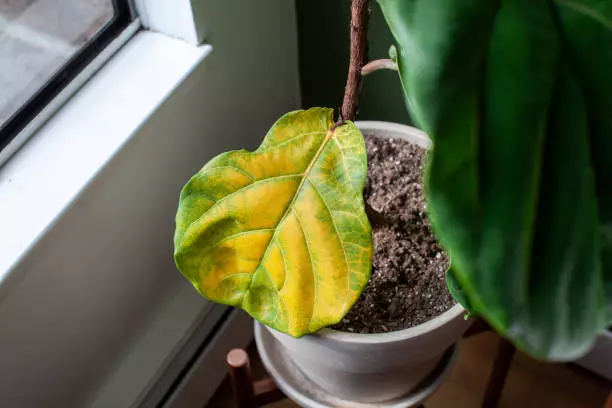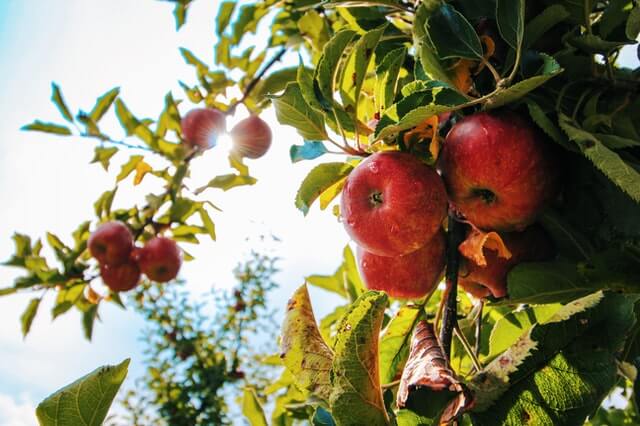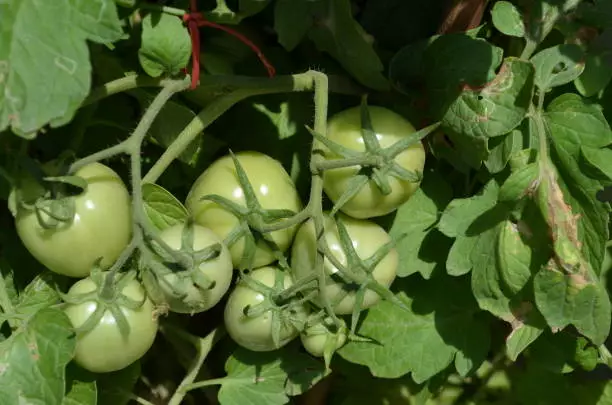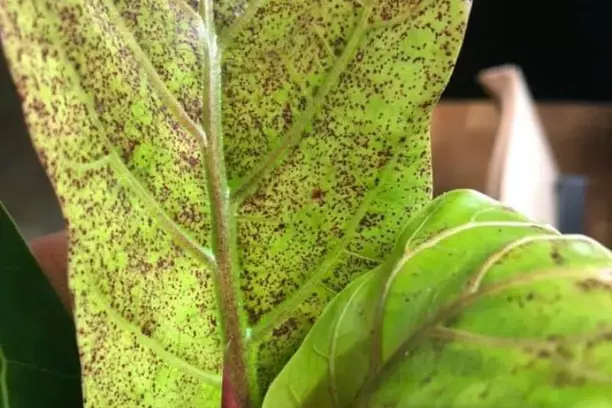Fiddle leaf fig (Ficus lyrata) is a popular houseplant that’s susceptible to several diseases, including root rot. When fully healthy, the plant’s roots appear firm and pliable. However, if the roots feel mushy and have a rotten smell, then you’re dealing with fiddle leaf fig root rot.
Root rot in fiddle leaf figs is caused by fungi in the soil due to overwatering or poorly draining soil. To treat root decay, uproot the plant and prune away the mushy, rotten roots. Treat the remaining roots using a hydrogen peroxide solution then repot the fig in a new, well-draining potting mix.
Signs: How to tell your fiddle leaf fig has root rot
Ficus lyrata root rot is caused by waterlogged soil that results from overwatering the fig or a poor-draining soil mix. Several fungi, bacterial, and fungi-like, soil-borne organisms thrive in such wet soil conditions, readily causing damage to the roots of the fiddle leaf fig.
The plant only thrives when its maintenance requirements are adequately met. This finicky ornamental plant will show signs of root damage if it is not well-cared for.
Here are the signs of root rot in fiddle leaf figs:
Leaves turning brown
The leaves may turn medium brown, dark brown, or black starting from the base, the center, or at the tips. However, Ficus lyrata leaf browning may also be caused by bacterial infection, drought, and pest infestation. Therefore, the surest way to ensure that root rot is the problem is to examine the roots themselves.
Mushy, rotting roots

Unpot your fiddle leaf fig and check out the roots. If they’re dark and mushy, then you have a root rot problem. Additionally, the rotten roots will feel wet due to the soil being waterlogged. Rotten Ficus lyrata roots also have a distinct decaying smell.
In some cases, rotting roots may be a sign of a severe bacterial infection in fiddle figs. It’ll be accompanied by dark, wet spots on the leaves.
RELATED: HOW TO TREAT FIDDLE LEAF FIG BACTERIAL INFECTIONS
Note: Brown fiddle leaf fig foliage will eventually drop off, as the plant tries to save itself from root rot damage.
Drooping and yellowing leaves

Root rot is also often associated with unhappy leaves in fiddle figs. The fiddle fig will have drooping leaves when overwatered since the plant is suffocating and is unable to draw in nutrients, water, and oxygen.
RELATED: HOW TO REVIVE FIDDLE LEAF FIG DROOPING LEAVES
In addition, the foliage may also start to turn yellow from poor nutrition when the roots are not functioning as expected.
If you see these signs, you want to diagnose your plant for root rot disease before it starts dying off slowly.
How to fix root rot in fiddle leaf figs
You can save your fiddle leaf fig from root rot by unpotting it and washing the root ball, cutting back the rotten roots and brown leaves, spraying the root ball with a hydrogen peroxide solution, and replanting it in a well-draining potting mix.
1. Uproot the fiddle leaf fig and clean the roots
Start by removing the fiddle leaf fig from its growing pot. After unrooting the plant, wash up the root ball to remove the excess soil stuck to the roots. After cleaning the roots, you can now easily identify the rotten roots from the ones that are still healthy.
2. Prune the damaged roots and leaves
Cut off the rotten root hairs using a pair of scissors or pruning shears, leaving only the healthy ones. Once you’re done, proceed to prune off the browning foliage as well to help the plant redirect its energy towards growing new foliage when it’s repotted.
Don’t prune off most of the plant’s leaves, as this will affect photosynthesis and further stress out the plant. Ideally, you should prune off no more than 30% of your fiddle leaf fig’s foliage.
3. Spray the root ball with hydrogen peroxide
Even after pruning off the affected roots, some of the root rot fungi and fungi-like organisms (including Fusarium, phytophthora, and pythium) may still be lingering on the healthy roots, waiting to cause further root damage once the fiddle leaf fig is replanted. You can kill off these disease-causing organisms by applying a hydrogen peroxide solution.
Mix 3% hydrogen peroxide with water in a ratio of 1:2 then pour the solution into a spray bottle and spray the roots of the fiddle leaf fig tree. Use this solution to sterilize the pot as well to kill all the fungi causing root rot before repotting the plant.
Commercial fungicides work just as well as hydrogen peroxide. However, before dipping your Ficus lyrata roots inside a fungicide solution, make sure to follow the manufacturer’s instructions.
4. Repot the plant in a new potting mix
With the diseased roots pruned off and the healthy ones freed of disease-causing microbes, you can now repot your fiddle leaf fig. Ideally, you want to replant your Ficus lyrata in a well-draining soil mix that won’t retain excess water that will trigger root rot. As for the container, it should have drainage holes to enable proper water drainage.
If you’re using a homemade soil mix comprising compost material, I recommend killing off any root rot pathogens present using hydrogen peroxide before repotting. Water the plant with the peroxide solution 2-3 times over seven days before replanting.
Note: The hydrogen peroxide solution will not only disinfect the potting mix but also enhance the soil oxygen levels, further boosting your fig’s root growth.
If you’ve replaced the soil mix but would still wish to replant the fiddle leaf fig in the same pot as before, wash the container with a bleach solution. This will kill off any fungal or bacterial organisms still lingering in the pot.
Can a fiddle leaf fig recover from root rot?
You can save and revive your fiddle leaf fig from dying if you discover the disease early enough and if some of the roots are still healthy. Repot the fig and water only when the top 1-2 inches of soil is dry. Cut off the top of the plant way back to the trunk to make it sprout new foliage.
Tips to prevent root rot
You can prevent root rot in your fiddle leaf fig by avoiding overwatering, planting the fig in well-draining and well-aerated soil, and providing optimal light conditions.
Here are great tips to prevent root rot in fiddle leaf figs:
Avoid overwatering
Root waterlogging may also occur if you’re feeding the soil with water too frequently. To avoid overwatering your fiddle leaf fig’s roots, allow the roots to dry out in between irrigation sessions. To test the potting mix for dryness, use a soil moisture meter or stick a finger onto the top two inches of the soil and feel for wetness.
Note: Dry soil conditions also push root rot pathogens back from the roots and further down into the soil, as they prefer wetter conditions.
Plant in well-draining soil
You should plant your fiddle leaf fig in well-draining soil that’s not too compact. Well-aerated soil allows oxygen to reach the plant’s root and allows water to drain through at the proper rate.
Ensure the appropriate light conditions
Fiddle leaf figs thrive in bright and warm conditions like those of their native rainforests of West Africa. As such, we recommend providing the plant with bright but indirect light. As for indoor figs placed next to a window, install window drapes to filter out the sun’s UV rays.
Note: By providing optimal light conditions, you’ll be boosting your Ficus lyrata’s natural defenses against disease-causing pathogens like root rot bacteria as well as resistance against pests.
References:
[1] Brian Hudelson, UW-Madison Plant Pathology: Root Rots on Houseplants
[2] D. J. Norman and Gul Shad Ali, University of Florida IFAS Extension: Ornamental Ficus Diseases: Identification and Control



